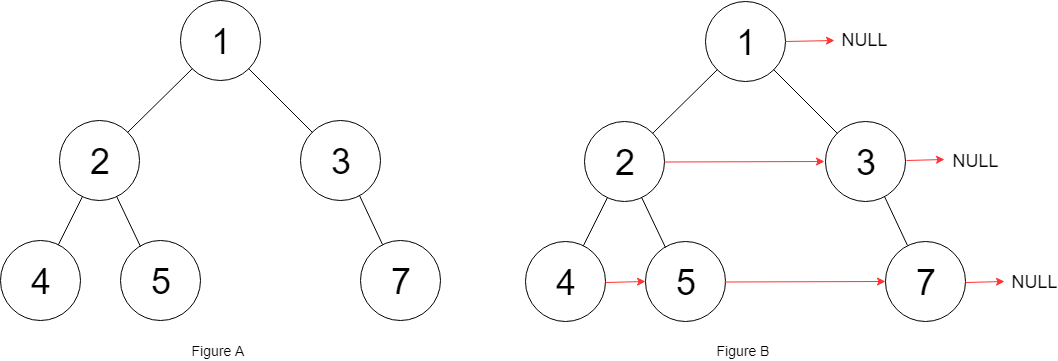Given a binary tree
struct Node {
int val;
Node *left;
Node *right;
Node *next;
}
Populate each next pointer to point to its next right node. If there is no next right node, the next pointer should be set to NULL.
Initially, all next pointers are set to NULL.
Example:

Input: {"$id":"1","left":{"$id":"2","left":{"$id":"3","left":null,"next":null,"right":null,"val":4},"next":null,"right":{"$id":"4","left":null,"next":null,"right":null,"val":5},"val":2},"next":null,"right":{"$id":"5","left":null,"next":null,"right":{"$id":"6","left":null,"next":null,"right":null,"val":7},"val":3},"val":1}
Output: {"$id":"1","left":{"$id":"2","left":{"$id":"3","left":null,"next":{"$id":"4","left":null,"next":{"$id":"5","left":null,"next":null,"right":null,"val":7},"right":null,"val":5},"right":null,"val":4},"next":{"$id":"6","left":null,"next":null,"right":{"$ref":"5"},"val":3},"right":{"$ref":"4"},"val":2},"next":null,"right":{"$ref":"6"},"val":1}
Explanation: Given the above binary tree (Figure A), your function should populate each next pointer to point to its next right node, just like in Figure B.
Note:
- You may only use constant extra space.
- Recursive approach is fine, implicit stack space does not count as extra space for this problem.
这道是之前那道 Populating Next Right Pointers in Each Node 的延续,原本的完全二叉树的条件不再满足,但是整体的思路还是很相似,仍然有递归和非递归的解法。我们先来看递归的解法,这里由于子树有可能残缺,故需要平行扫描父节点同层的节点,找到他们的左右子节点。代码如下:
解法一:
class Solution {
public:
Node* connect(Node* root) {
if (!root) return NULL;
Node *p = root->next;
while (p) {
if (p->left) {
p = p->left;
break;
}
if (p->right) {
p = p->right;
break;
}
p = p->next;
}
if (root->right) root->right->next = p;
if (root->left) root->left->next = root->right ? root->right : p;
connect(root->right);
connect(root->left);
return root;
}
};
对于非递归的方法,我惊喜的发现之前的方法直接就能用,完全不需要做任何修改,算法思路可参见之前的博客 Populating Next Right Pointers in Each Node,代码如下:
解法二:
// Non-recursion, more than constant space
class Solution {
public:
Node* connect(Node* root) {
if (!root) return NULL;
queue<Node*> q;
q.push(root);
while (!q.empty()) {
int len = q.size();
for (int i = 0; i < len; ++i) {
Node *t = q.front(); q.pop();
if (i < len - 1) t->next = q.front();
if (t->left) q.push(t->left);
if (t->right) q.push(t->right);
}
}
return root;
}
};
虽然以上的两种方法都能通过OJ,但其实它们都不符合题目的要求,题目说只能使用constant space,可是OJ却没有写专门检测space使用情况的test,那么下面贴上constant space的解法,这个解法也是用的层序遍历,只不过没有使用queue了,我们建立一个dummy结点来指向每层的首结点的前一个结点,然后指针cur用来遍历这一层,我们实际上是遍历一层,然后连下一层的next,首先从根结点开始,如果左子结点存在,那么cur的next连上左子结点,然后cur指向其next指针;如果root的右子结点存在,那么cur的next连上右子结点,然后cur指向其next指针。此时root的左右子结点都连上了,此时root向右平移一位,指向其next指针,如果此时root不存在了,说明当前层已经遍历完了,我们重置cur为dummy结点,root此时为dummy->next,即下一层的首结点,然后dummy的next指针清空,或者也可以将cur的next指针清空,因为前面已经将cur赋值为dummy了。那么现在想一想,为什么要清空?因为我们用dummy的目的就是要指到下一行的首结点的位置即dummy->next,而一旦将root赋值为dummy->next了之后,这个dummy的使命就已经完成了,必须要断开,如果不断开的话,那么假设现在root是叶结点了,那么while循环还会执行,不会进入前两个if,然后root右移赋空之后,会进入最后一个if,之前没有断开dummy->next的话,那么root又指向之前的叶结点了,死循环诞生了,跪了。所以一定要记得清空哦,呵呵哒~
这里再来说下dummy结点是怎样指向每层的首结点的前一个结点的,过程是这样的,dummy是创建出来的一个新的结点,其目的是为了指向root结点的下一层的首结点的前一个,具体是这么做到的呢,主要是靠cur指针,首先cur指向dummy,然后cur再连上root下一层的首结点,这样dummy也就连上了。然后当root层遍历完了之后,root需要往下移动一层,这样dummy结点之后连接的位置就正好赋值给root,然后cur再指向dummy,dummy之后断开,这样又回到了初始状态,以此往复就可以都连上了,代码如下:
解法三:
// Non-recursion, constant space
class Solution {
public:
Node* connect(Node* root) {
Node *dummy = new Node(0, NULL, NULL, NULL), *cur = dummy, *head = root;
while (root) {
if (root->left) {
cur->next = root->left;
cur = cur->next;
}
if (root->right) {
cur->next = root->right;
cur = cur->next;
}
root = root->next;
if (!root) {
cur = dummy;
root = dummy->next;
dummy->next = NULL;
}
}
return head;
}
};
类似题目:
Populating Next Right Pointers in Each Node
参考资料:
https://leetcode.com/problems/populating-next-right-pointers-in-each-node-ii/
LeetCode All in One 题目讲解汇总(持续更新中…)
转载请注明来源于 Grandyang 的博客 (grandyang.com),欢迎对文章中的引用来源进行考证,欢迎指出任何有错误或不够清晰的表达。可以在下面评论区评论,也可以邮件至 grandyang@qq.com




